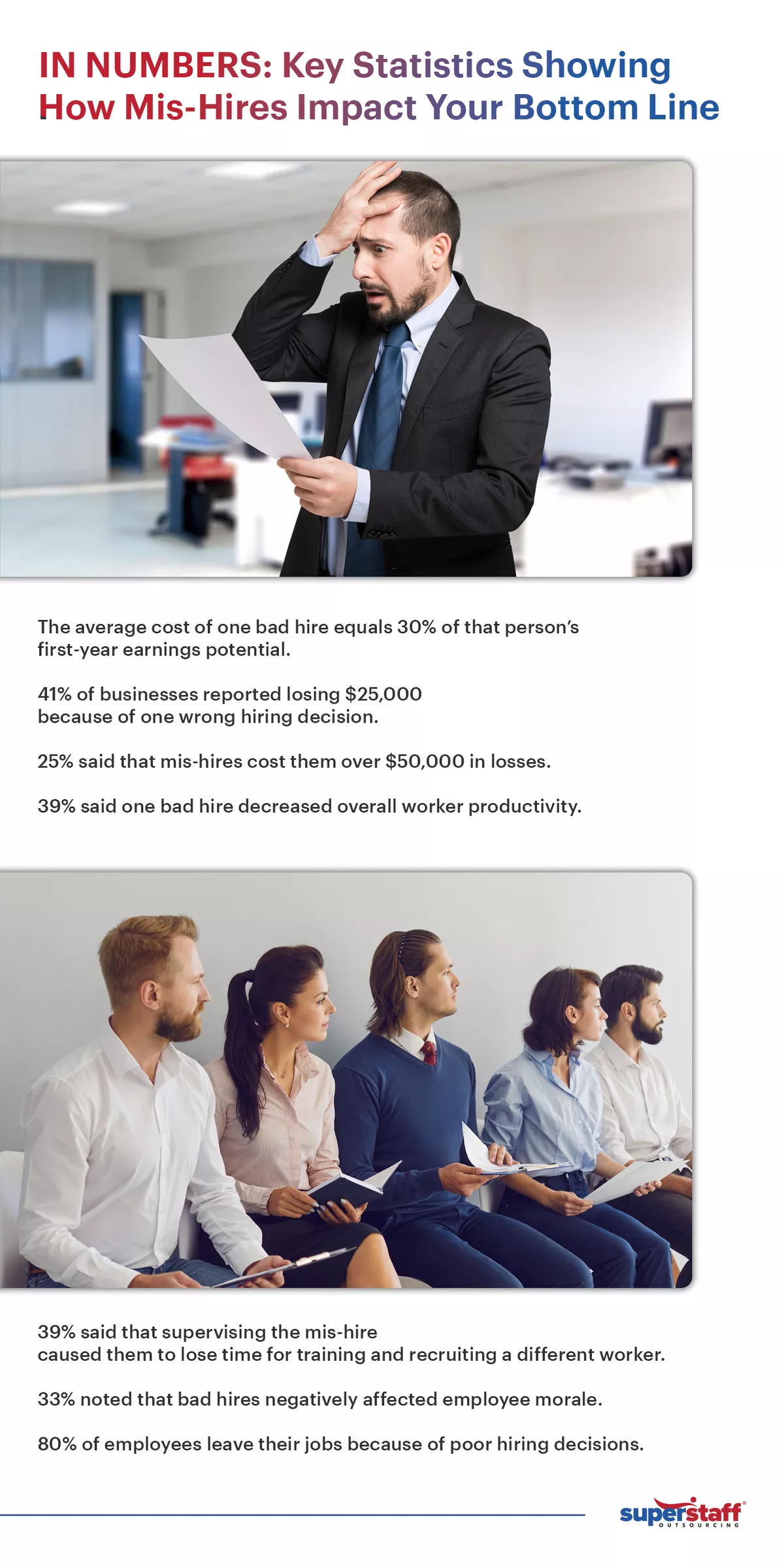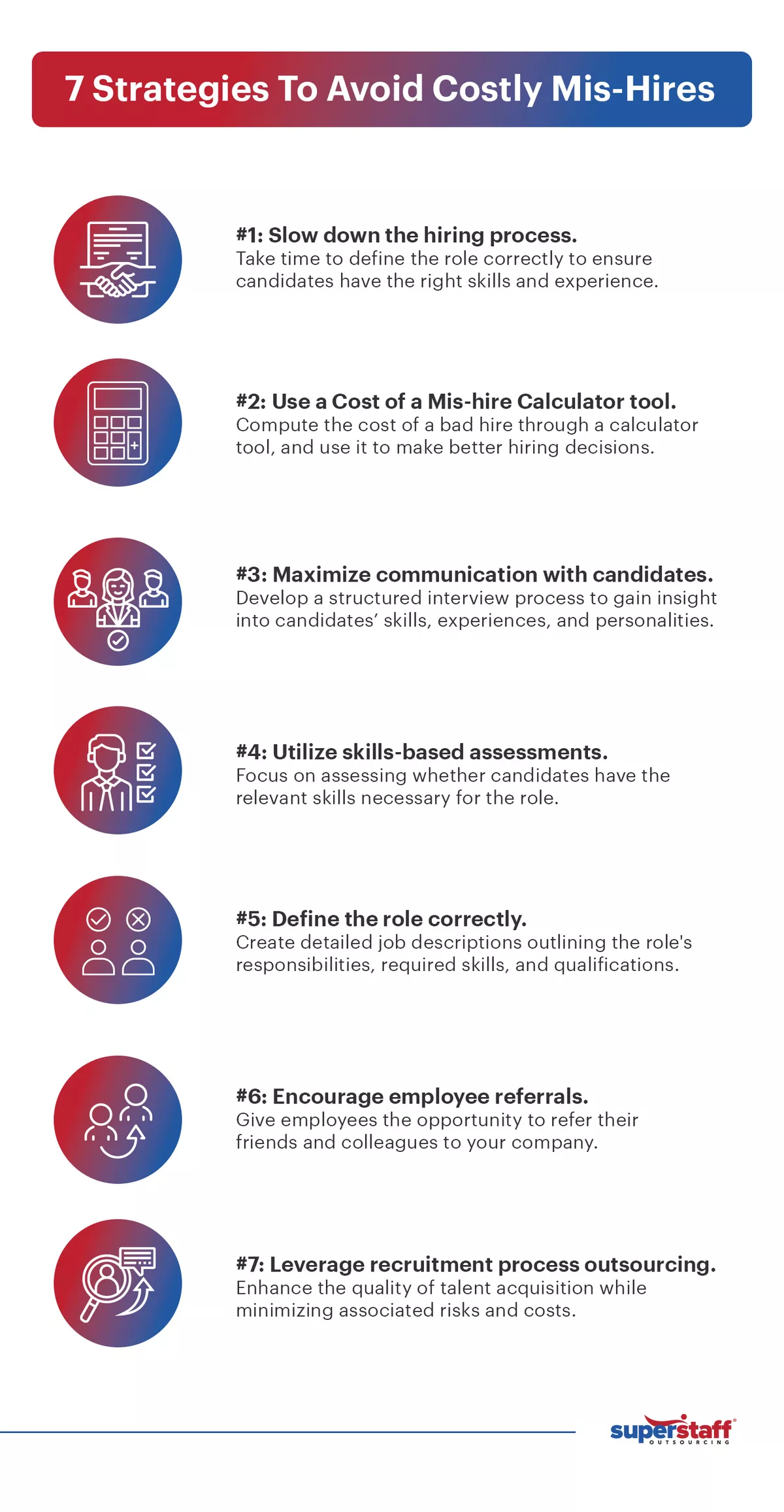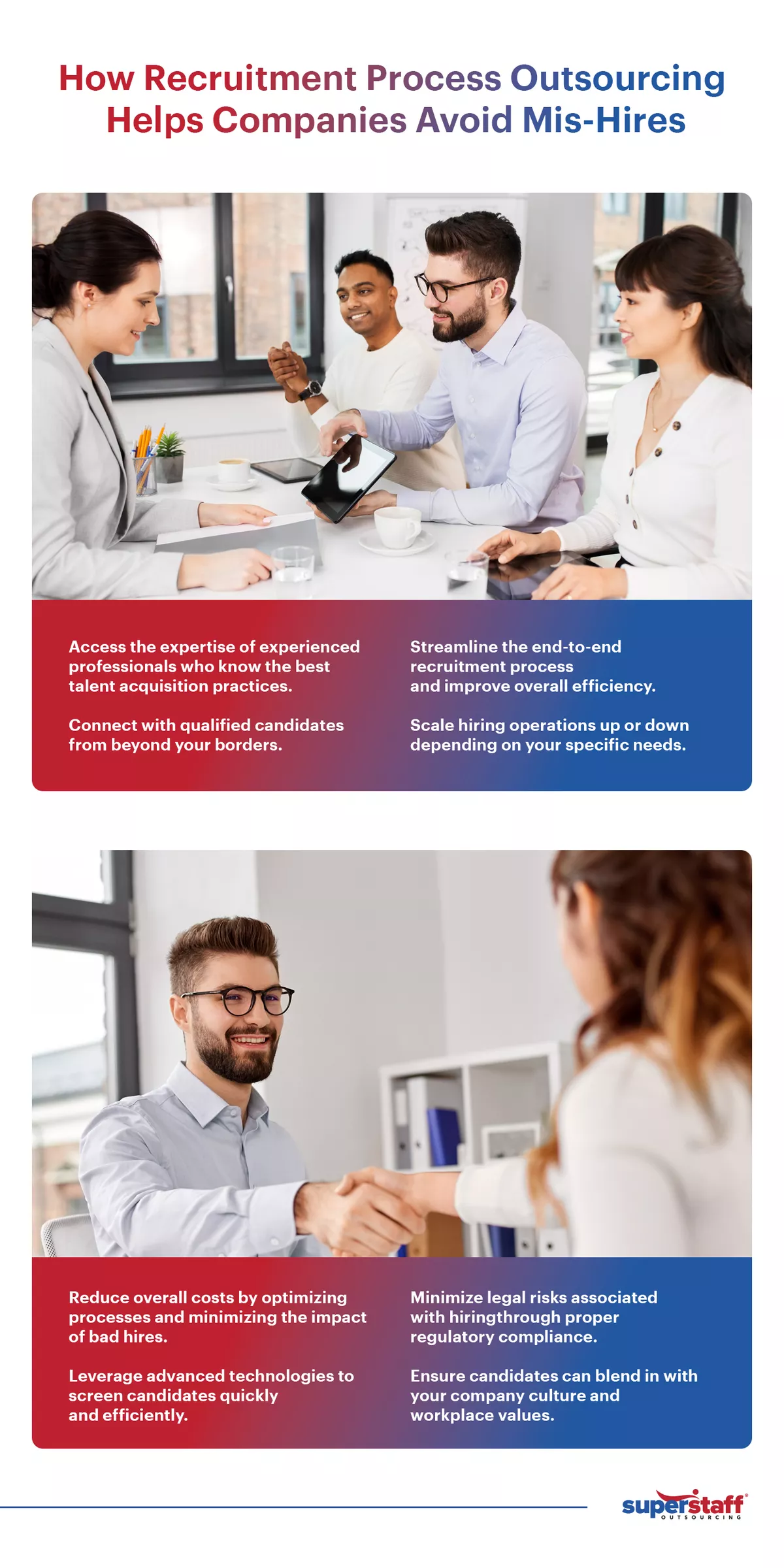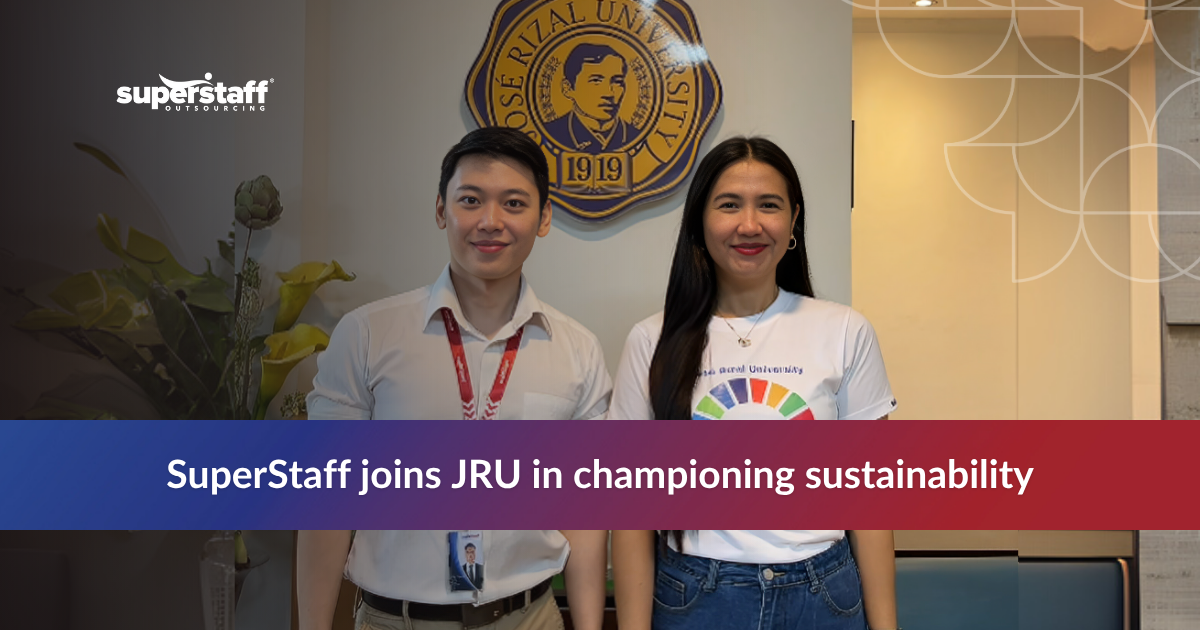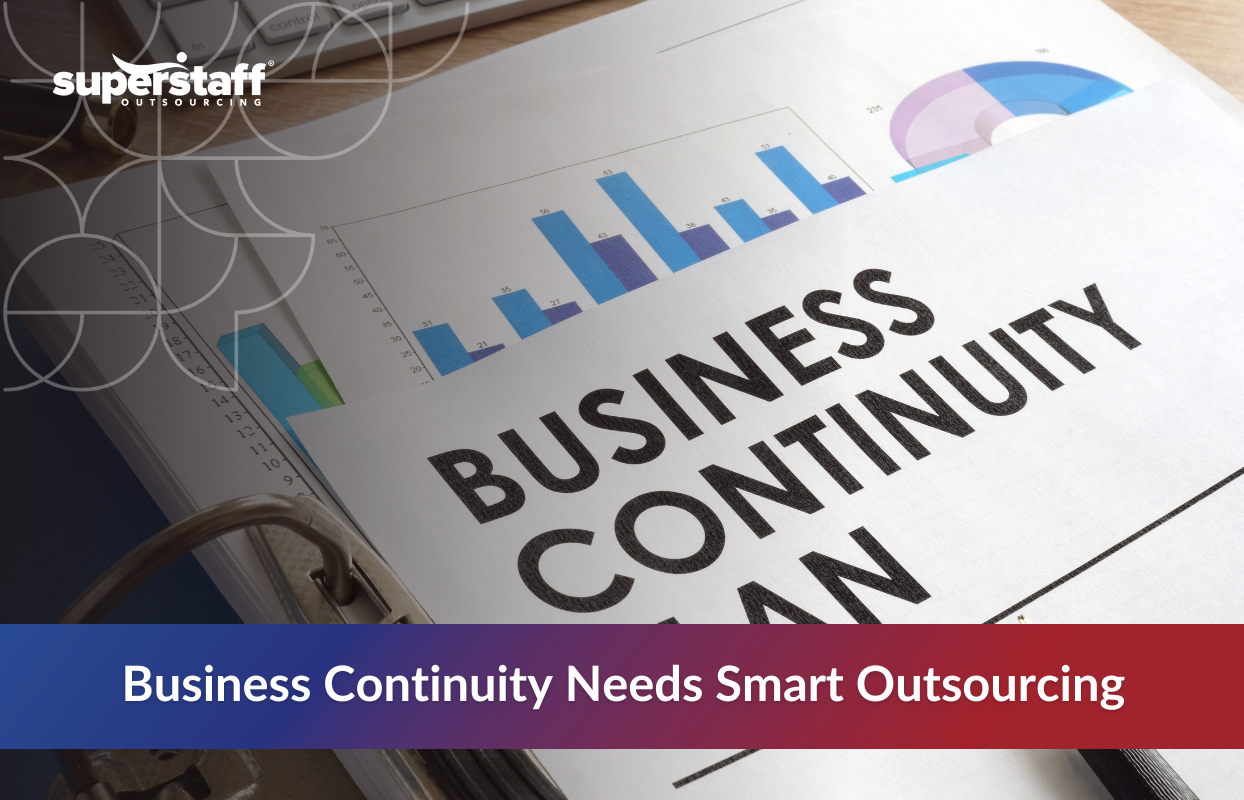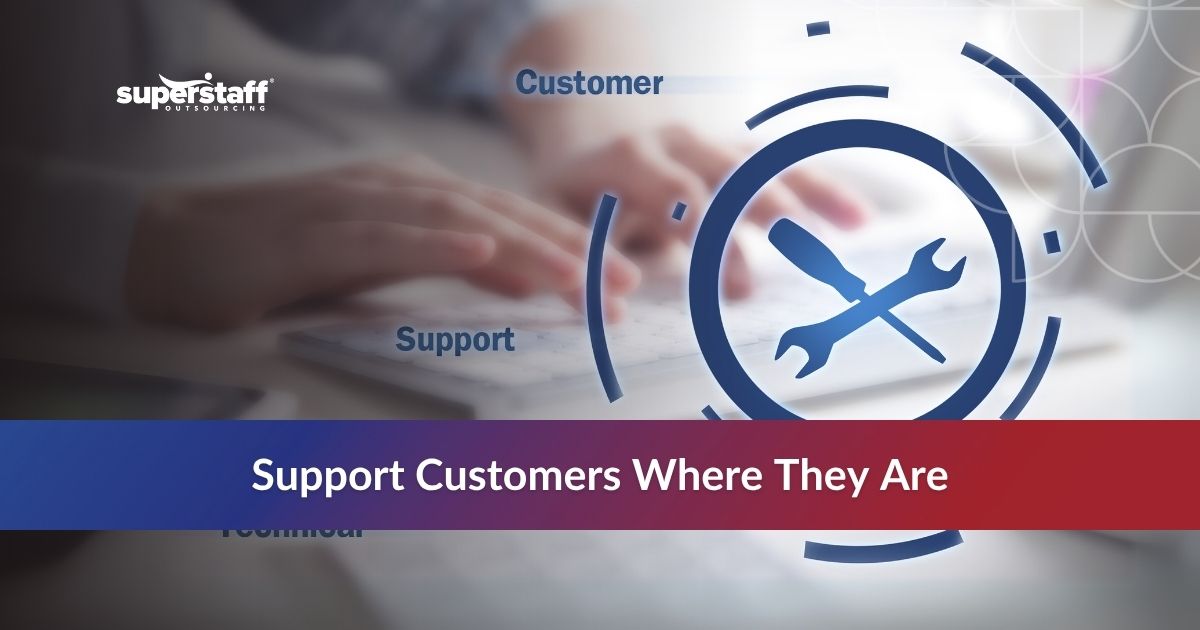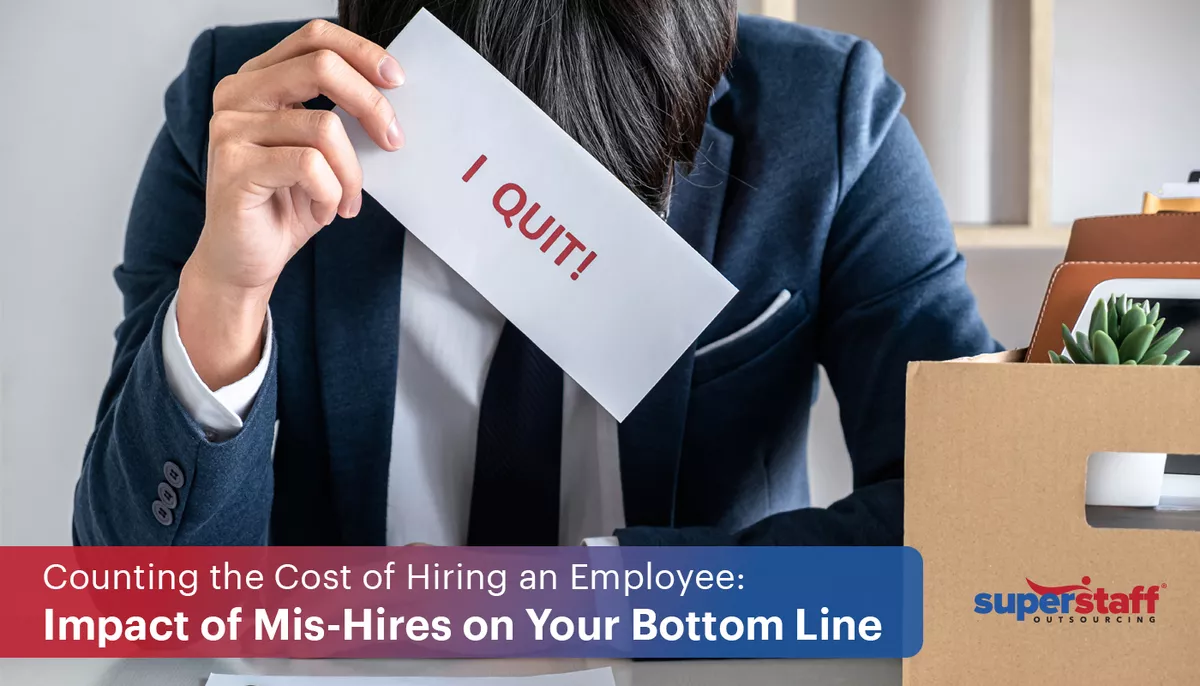
Employees are the lifeblood of any organization, driving innovation, productivity, and, ultimately, the company’s success. Every new hire brings something unique to the table, shaping the company’s energy, culture, and performance.
However, bringing new talent aboard isn’t without its perils. Mis-hires, or the recruitment of individuals who aren’t the right fit for the role or the company, can have substantial repercussions, extending well beyond the confines of the hiring process.
When calculating the cost of hiring an employee, businesses must consider the potential impact of mis-hires on their bottom line. One LeadershipIQ study found that 46% of newly hired employees are considered mis-hires, leading to poor performance and wasted time for all parties involved.
From financial implications to cultural disruptions, the fallout of a mis-hire can reverberate throughout an organization, impacting not only company resources but also employee morale and overall productivity.
The Unseen Cost of Hiring an Employee: 5 Ways Mis-Hires Impact Your Bottom Line
Recruitment and Training Costs
Hiring remains costly and time-consuming whether you’re a small business or a well-established enterprise. Mis-hires add even greater expenses because employers will take on all costs associated with recruitment, training, onboarding, salary, and employee benefits, plus potential severance packages when the new hire doesn’t work out.
The U.S. Department of Labor estimates that the average cost of one bad hire equals 30% of that person’s first-year earnings potential. So, for example, if you hire a professional with a salary of $45,000, replacing this employee will result in a loss of $13,500 for the business.
➡️Difficulty Finding Talent? Hear From Our Talent Acquisition Experts.
In a different survey from CareerBuilder, 41% of businesses reported losing at least $25,000 because of one wrong hiring decision, while 25% said that mis-hires cost them over $50,000.
Loss of Productivity
In addition to losing recruitment, onboarding, and training costs after a mis-hire, companies may also face lower productivity. Poor hiring decisions affect overall operational efficiency and performance because a bad hire might not possess the necessary skills to handle the workload, causing delays, errors, or disruptions in team dynamics.
Mis-hires can effectively slow down workflows because they require additional training or supervision. Or, perhaps, they don’t fit the company culture for a wide range of reasons, including having a negative mindset that prevents proper team collaboration, affects employee morale, and slows progress on crucial tasks.
According to the same CareerBuilder survey, 39% of business owners reported decreased worker productivity due to a bad hire. Meanwhile, 39% said that supervising the mis-hire caused them to lose time for training and recruiting a different worker, while 33% noted that employee morale was negatively affected.
Deflating Employee Morale
What is the cost of hiring an employee who doesn’t work well with your existing team and company dynamics? The answer is lower team morale and higher employee dissatisfaction.
The CareerBuilder research highlighted that 33% of businesses noticed a negative effect on employee morale after one mis-hire. Poor hires were found to have cynical or pessimistic attitudes (62%) and struggled to work well with their colleagues (63%).
A mis-hire can affect how other employees may feel about your company. For instance, if other team members have to pick up the slack or correct the mistakes of a poor hire, it can lead to dissatisfaction, demotivation, or even attrition among high-performing employees.
Negative Impact on Company Culture
Beyond lowering team morale, mis-hires also affect your overall company culture.
Workplace culture is not just about office perks like ping pong tables and Pizza Fridays; It involves how people interact, work together, and feel about each other. Even one poor hire can upset the delicate balance of your company ecosystem, turning a positive work environment into an exhausting or even toxic one.
Studies have found that over 80% of employees leave their jobs because of a company’s poor hiring decisions. As such, when you hire the wrong person, you risk not only losing one worker, but you’re potentially driving away your top performers as well.
Cultural misfits can disrupt the established work culture, leading to conflicts or misunderstandings among team members. Growing discontent and frustration between team members can affect collaboration and hinder innovation and progress.
At the same time, employees who feel like they’re carrying the weight of a poor performer may feel undermined or unappreciated, leading to lower satisfaction and productivity.
Lower Customer Satisfaction and Damage to Reputation
When calculating the average cost of hiring an employee, one factor that businesses may fail to consider is the cost of decreased customer satisfaction due to a mis-hire.
Remember: The cost of a poor hiring decision affects not only your employees but your customers as well. A mis-hired worker may provide substandard work, failing to meet the needs and expectations of your clients and lowering customer satisfaction.
In today’s competitive business landscape, one lousy interaction is enough for a customer to turn away for good. A Calabrio survey found that over 60% of consumers switch brands after a single negative experience.
Frustrating one customer can then lead to a domino effect of bad publicity. Today, many buyers discuss their negative brand experiences with family and friends or even post bad reviews and comments online, damaging your company’s reputation.
How To Hire a New Employee That Fits the Bill: Key Strategies To Avoid Costly Mis-Hires
Slow down the hiring process.
When companies are in a hurry to fill a role, what tends to happen is they only interview a few candidates. As soon as they find someone who somewhat matches their requirements, they hire them immediately without performing more in-depth screening, interviewing, and background checks.
The problem is that this approach significantly increases the chances of mis-hires. You might have filled an immediate gap but disrupted your team dynamics by bringing in a new hire who may need more supervision, lack specific skills and knowledge, doesn’t work well with others, or simply isn’t a good fit for your company culture.
➡️Know More About Our Sample Hiring Timelines. Contact Us.
To avoid this problem, slow down your hiring process. Even if recruitment takes longer, finding the right candidate can help you save more time and resources in the long run. Take the time to define the role correctly, contact references, and use skills-based assessments to ensure the candidate has the necessary skills and experience.
Introduce potential hires to your team.
If you trust and value your existing team members, introducing potential new hires to them may be a good idea before making your final decision. Doing so shows them that you care about their input and feedback and want to hire someone who will fit your company’s culture and values well.
As much as possible, be clear about your expectations with the candidate as early as the interview stage. Tell them not just about their role and responsibilities but also about the demeanor and conduct you hope to see from them in the workplace.
Use a Cost of a Mis-hire Calculator tool.
For businesses wondering how to calculate the cost of hiring an employee, using a recruitment calculator that estimates time wasted and the overall cost of a poor hire can be helpful when making decisions. Here are some factors to consider when calculating the cost of mis-hires:
- Recruitment: Calculate how much you spent on recruitment, including posting on job boards, advertising your employer brand, screening, interviewing, and onboarding.
- Training and Compensation: Estimate how much you spent on training and compensating the mis-hire, including bonuses, health insurance, or any other employee benefit.
- Cost of Employee Turnover: Determine how many top-performing employees exited the company due to poor hiring decisions and how much it costs to fill their roles.
- Performance Losses: Forecast potential losses caused by the lowered productivity and performance of the mis-hired employees and customer dissatisfaction rates.
Maximize communication with candidates.
When performing external recruitment, companies must maximize communication with candidates to gain in-depth insight into their skills, experiences, and personalities. Don’t view interviews as a one-off transaction; instead, see it as an opportunity to get to know the applicant and determine whether they fit the role and your company culture well.
One key strategy is to develop a structured interview process with standardized questions. Behavioral interviews focusing on past experiences can reveal more about a candidate’s abilities and fit within the company culture.
Use skills-based assessments.
Instead of relying on guesswork or basing hiring decisions on educational background or past career titles, more businesses are utilizing skill-based assessments. Standardized skills tests determine whether a candidate can perform the work necessary for the role, reducing the chance of mis-hires.
A recent study found that most employers (76%) use skill-based hiring in their recruiting process, with more than half (55%) using tests that assess specialized roles. In addition, using skill evaluation tests has created tremendous outcomes for companies, leading to the following:
- Fewer Overall Mis-Hires (92.7%)
- Reduced Time-to-Hire (91.4%)
- Lower Overall Cost-to-Hire (89.8%)
- Happier Employees (72.1%)
- Increased Employee Retention (91.2%)
Beyond evaluating a candidate’s skills and ensuring they are a good fit for the role, skill-based assessments help your hiring team avoid recruitment bias and focus only on characteristics and knowledge relevant to the role. The same study found that 91% of companies also fostered greater workplace diversity after switching to skill-based hiring.
Define the role correctly.
Avoiding mis-hires doesn’t start at the interview stage. You can begin attracting the right candidates as early as the first job application post.
Before posting on any online job boards, review your job description. Does it clearly define the roles and responsibilities of the position? Have you included all relevant skill requirements and qualifications?
Make sure your description clearly and accurately describes what is expected of the candidate so you can reel in only applicants who genuinely match your specific needs.
Encourage employee referrals.
Another strategy for strengthening the overall quality of hires is to encourage your existing employees to refer their friends or colleagues. Studies have found that employee referrals (45%) are more likely to stay at a company for longer than four years than job board hires (25%).
At the same time, employers reported that referrals have a $1,000-less cost-per-hire compared to other recruiting methods. Since referrals are often people your employees already know and have worked with, they are more likely to fit well within existing team dynamics and company culture.
Leverage recruitment process outsourcing.
Finally, a solid strategy for reducing mis-hires is to work with an experienced provider of recruitment process outsourcing. This strategy allows you to tap into the expertise of recruiting professionals while minimizing associated risks and costs.
With RPO solutions, companies can benefit from a streamlined, efficient, and expertly managed recruitment process that gives them access to a broader talent pool and increases the quality of hires. Here’s why you should consider working with an RPO provider:
➡️ Outsourcing Made Easy? Book a Free Call
Expertise and Specialization
RPO providers often specialize in recruitment, possessing extensive knowledge of sourcing, screening, and assessing candidates. Their expertise allows for a more refined selection process, minimizing the risk of bad hires.
Access to Talent Pools
RPO firms typically have access to broader talent networks and databases. As such, they can connect you with candidates who might not be accessible through traditional hiring methods, increasing the likelihood of finding the right fit for your company.
Streamlined Processes
With an RPO provider, companies can streamline the entire hiring process, from job profiling to onboarding. This structured approach ensures that every step, including candidate evaluation and background checks, is meticulously executed, reducing the chances of making the wrong hiring decision.
Scalability and Flexibility
Businesses that work with RPO companies can more easily scale their operations up or down based on their hiring needs. This flexibility allows for efficient resource allocation, ensuring the focus remains on quality hires without compromising speed.
Cost Efficiency
While hiring an RPO service involves an initial investment, it can still be more cost-effective in the long run. RPO providers often bring in economies of scale, reducing overall recruitment costs by optimizing processes, lowering employee costs, and minimizing the impact of bad hires on your company’s bottom line.
Technology and Innovation
RPO firms leverage advanced technology, including applicant tracking systems (ATS), AI-powered screening tools, and analytics. These innovations help them identify the most suitable candidates efficiently and accurately.
Compliance and Risk Mitigation
In addition to being well-versed in the best hiring practices, RPO providers must comply with industry-specific rules and regulations. As such, companies working with RPOs can minimize the legal risks associated with hiring, ensuring that the candidates selected meet all necessary regulatory requirements.
Focus on Company Culture
RPO services can be tailored to align with your company’s culture and values. Providers consider the specific cultural aspects of your organization, ensuring that candidates are skilled and fit into the company’s ethos.
Protect Your Workforce from Bad Hires and Keep Hiring Costs in Check
➡️Connect With Thousands of Talent Worldwide! Contact Us
Before counting the cost of hiring an employee, don’t forget to consider the potential impact of mis-hires on your existing employees and customers. The right RPO provider can help you keep recruitment costs low while driving up the quality of hires, helping you protect your workforce and prevent any operational disruptions.
SuperStaff offers end-to-end recruitment process outsourcing services, working closely with clients to fill talent gaps in their organizations. Our RPO team takes a holistic approach to hiring, prioritizing everything from candidate screening and selection to onboarding and workforce management.
Contact us today to learn more about our RPO services!

